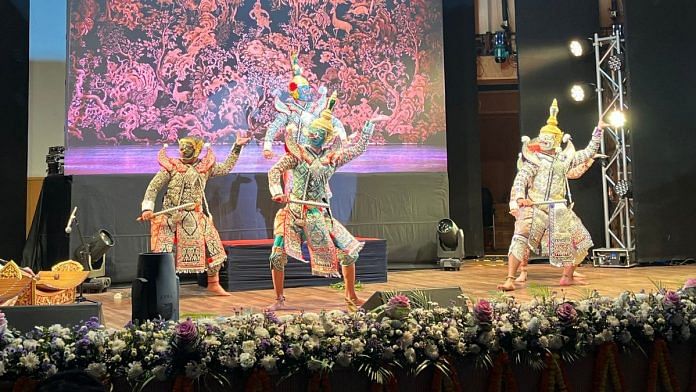New Delhi: There is no greater unifier, no greater consolidator than the Ramayana. This is the tack the Indian government has been following, using the legend as a metonym for India’s civilisational supremacy. Now, neighbouring Thailand has taken this cue to make a connection with Indians.
At a Khon performance, Thailand’s masked dance form known for its theatricality, this was on full display. A recreation of the Ramayana was part of the Namaste Thailand Festival, a cultural event organised by the Royal Thai Embassy in New Delhi from 8 to 9 February. Twenty-five dancers and six musicians put on a show that had an audience––many of whom appeared to be unfamiliar with the dance form––enthralled by what was a sheer spectacle.
“Namaste Thailand is a celebration of an important partnership that India has. Our relationship goes back a thousand years,” said Nandini Singla, Director General of the Indian Council for Cultural Relations (ICCR). “A time when our maritime traders carried not just products to Thailand but our culture. This shared history, civilisation and our cultural ties have resulted in a robust partnership.”
This was reiterated by Thai Chargé d’Affaires Thirapath Mongkolnavin, who said the festival celebrates not just Thai culture but also the “deep-rooted cultural connections that have enriched Thailand and India.”
Singla, in her introductory remarks, also mentioned that at the 18th Pravasi Bharatiya Divas held in January in Odisha, Prime Minister Narendra Modi was particularly moved by a painting depicting the Khon.
Also read: Migrants are more than just a problem–they enrich cultures too
‘A universal legacy’
Slow, deliberate movements accompanied by delicate, extended poses marked this version of the Ramayana, which was divided into five acts and focused on Hanuman. Each scene was acted out, with the dance relying less on interpretation than one might expect.
Battles spill into the audience—with Ram and Sita cocooned in a corner. Up until the rest of his clan is defeated, Ram engages Ravana in what is a rather thrilling, intimate battle sequence. Unfortunately, this ends in Sita’s abduction. And she steps off the stage with Ravana, presented as such through an emerald green mask. Meanwhile, Ram stuck to more pastel colours.
Khon is an amalgamation of several forms of movement. And not all of them are ‘artistic’. For example, it also involves martial arts––albeit performed in more intricate headgear. It draws heavily from Ram and the Ramayana, and always portrays the victory of good over evil.
Khon’s an instructive dance form, a channel through which a tale of triumph emerges. That is perhaps why the production itself was impressive. Dancers wore garments that resembled saris, and the use of brocade was ample. Props were the highlight, with Hanuman playing on a stage that masqueraded as a garden––with real flowers to boot.
Predictably, Ram and Hanuman lead their army to victory. It was a testament to what Singla called “the universal legacy of the Ramayana.”
“It was born in India, but today, it belongs to the world,” she said.
(Edited by Aamaan Alam Khan)







Ms. Antara Baruah’s contempt for anything Hindu is quite well known. She has repeatedly mocked and belittled Hindu traditions and culture. One could clearly see that she is ashamed of her Hindu heritage.
It’s surprising that she wrote a glowing account of the Ramayana performance. Does not suit her style of “journalism”.